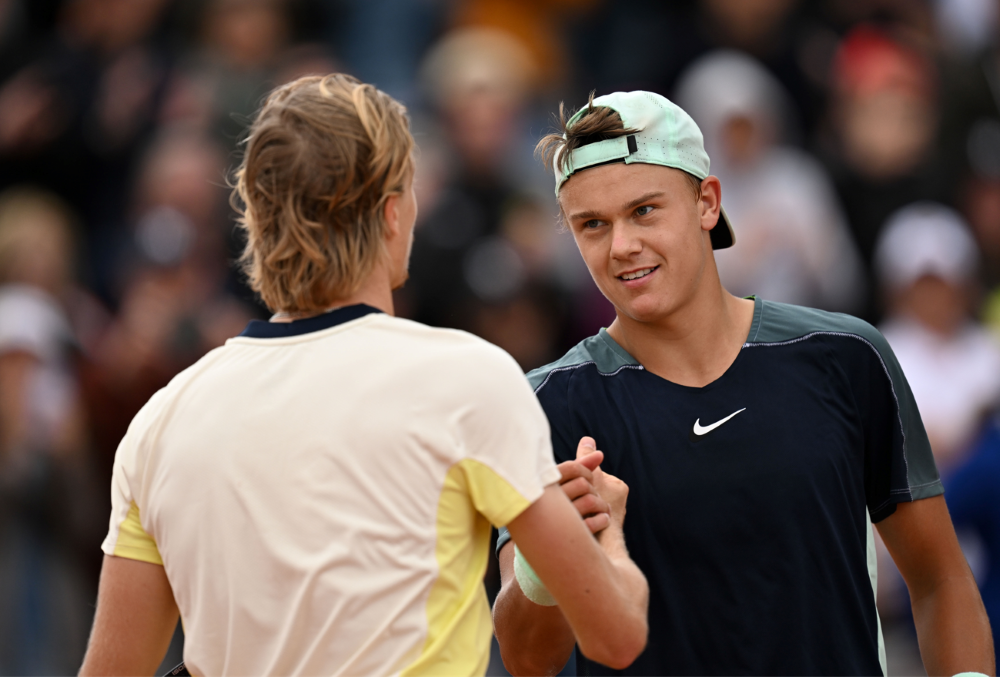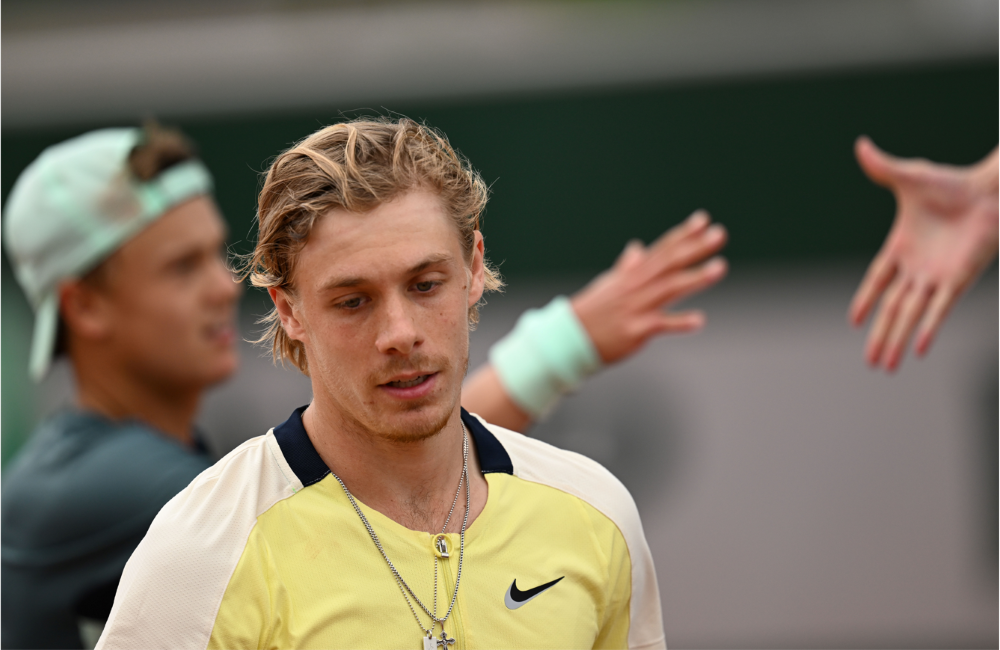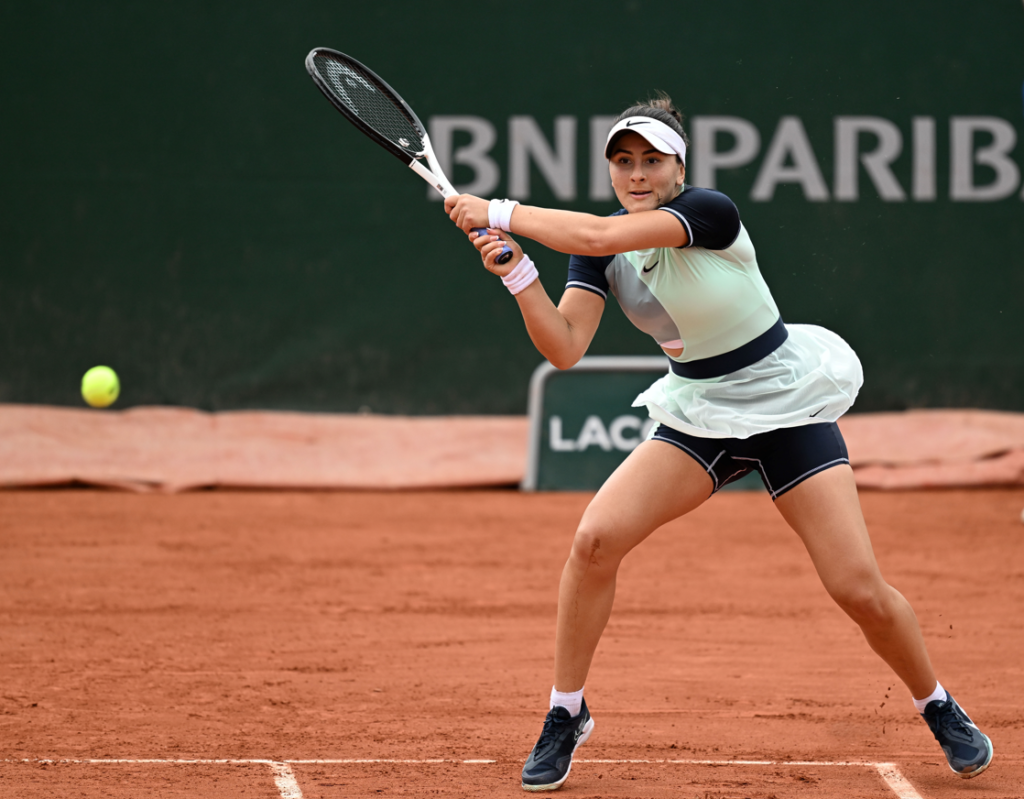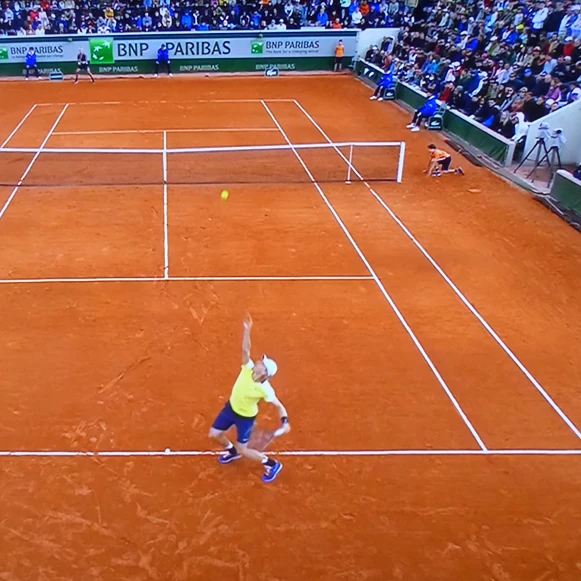The French sometimes use the term ‘contre-performance’ (literally a counter-performance) to describe a bad outing by a player.
Sadly for Denis Shapovalov fans, the 23-year-old Canadian had one of those in the first round of the French Open on Tuesday – losing 6-3, 6-1, 7-6(4) to fast-rising Holger Rune on Court 12.
Who knows, but it might have been different if Shapovalov had converted a break point against the 19-year-old Dane in the fourth game of the match. At 30-40, the players engaged in a baseline rally and Rune boldly hit full out, finishing with a wrong-footing forehand winner.
It was a sign of things to come as he played aggressively and with very few unforced errors while Shapovalov was all over the map, including missing a high backhand volley in the very next game to give Rune the break and a 3-2 lead.
He carried that separation all the way to a match point serving and leading 5-4 in the final set. Then, with a sitter forehand near the net, he missed it into the net. Clearly, the pressure of the moment, with his chance for a first victory in a Grand Slam tournament, got to him.
Finally, after struggling for so long, Shapovalov had an opening to extend the match. The momentum began to swing his way and he took advantage to break back – on his first break point since that fourth game of the match – to level at 5-all.
He then served out to love for 6-5 and suddenly seemed to have new life and to be grabbing control. He even got to a potentially match-changing set point in the 12th game only for Rune to hit a daring backhand drop shot that Shapovalov retrieved but pushed wide. The set went to a tiebreak and, when Shapovalov hit two acrobatic overheads in one point to take a 1-0 lead, it seemed he might be back in the groove. But Rune quickly turned things around. The mini-break advantage he got to lead 3-1was all he needed and he finally closed out the two-hour match when Shapovalov hit a forehand well wide on his second match point.

The Dane deserves full credit for the win. He was incredibly steady from the baseline the whole match – finishing with 17 winners and 19 unforced errors to 27 winners and 53 unforced errors for Shapovalov.
There was a telling match stat that was highly unlikely – Shapovalov had six aces and six double faults while Rune was zero aces and zero double faults. It’s rare that a men’s best-of-five match would have zero aces, but it was the zero double faults that stands out because it showed just how consistent Rune was and how well he performed under pressure.

There remains a question about Shapovalov (his support group above) on clay. He has one of the best constitutions on tour – he never seems to get tired. He’s also strong as an ox. So that begs the question why doesn’t he sometimes – especially on clay – just play more long points, stay in rallies and challenge an opponent to try to stay with him physically.
“If I feel this way,” he said candidly about Tuesday’s poor form, “have kind of a plan B or something that I can change to help me kind of change my feelings or change the game. But again, I play a very aggressive game, so when I’m off, I’m off. So it’s kind of like that.”

There’s no shame in the loss to the No. 40-ranked Rune, who was widely viewed as one of the two or three most dangerous (non-seeded) floaters in the draw.
Still, there were too many gifts by Shapovalov – a completely botched smash on top of the net into the net to lose serve at 4-all in the third set as well as two double faults in a row to gift Rune the break to 2-0 in the second set at a moment when he wanted to send a message that he was regrouping and re-establishing himself in the match.
One hundred years ago in the 1920s, Canada’s best player was a man named Jack Wright from British Columbia. He was also a doctor with a medical degree from McGill University. Dr. Jack Wright had a motto that is timeless in its application to tennis then and now: “never miss an easy one.” Of course that’s easier said than done but it makes the point that players have to stay on the ball for every single shot, right until the point is over and done.

Post match, Shapovalov gave credit to Rune, while declaring “I didn’t show up today,” and mentioning the fact that the ATP is not awarding ranking points for Wimbledon has been on his mind the last few days. He’s defending 720 points (out of 2,531) from his Wimbledon semi-final a year ago and could drop from No. 15 to just outside the Top 20 if he’s not able to defend all or some of those points at the 2022 event.
While stating he didn’t agree with Wimbledon’s decision to bar Russian and Belarussian players or with the ATP Tour not awarding ranking points as a result, he said, “the most guys it’s affecting are the guys in the top rankings. Obviously Novak, me, Hubi (Hurkacz), Berrettini, who’s not playing here. We’re going to drop a lot.
“So it’s difficult. I think they could have gone with it a different way – maybe keep 50 per cent like they have in the past or some kind of fairness. But even a guy like (No. 57 Marton) Fucsovics is going to drop out of the top 100.”
“So it’s difficult for the players when you don’t have a chance to defend and especially on a surface like grass where it’s already so short and the players that play well on that surface they don’t have that many opportunities to make points. So you take a huge chunk of it out. It’s super difficult for players.” Following the match, he was non-committal about whether he would play Wimbledon.

The popcorn match of day four should be Bianca Andreescu versus No. 14 seed Belinda Bencic. The two memorably played in the US Open semi-finals in 2019, the year Andreescu won the title. That has been their only meeting.
Both come into the match with questions about their play since the start of 2022. Bencic got COVID-19 while playing an exhibition in Abu Dhabi in December, a case she described as severe. Then in February she was diagnosed with a lung issue that was supposed to take three months to clear up. This clay-court season she has reached the final in Charleston (Ons Jabeur), the round of 16 in Madrid (Jabeur), and the second round in Rome (Amanda Anisimova), while playing herself back into form.
As for Andreescu, she took a six-month break before returning in Stuttgart last month and has gone 7-3 at events in Stuttgart, Madrid, Rome and the first round of Roland Garros. She has beaten some good players – No. 12 Emma Raducanu, No. 8 Danielle Collins and No. 42 Alison Riske – and lost while being competitive to No. 4 Aryna Sabalenka, No. 14 Jessica Pegula and No. 1 Iga Swiatek. It has been apparent she’s getting progressively better – and a hard struggle over two hours to beat the huge-hitting of Ysaline Bonaventure on Monday may be just what she needed to be match tough for Bencic.

The other Canadian woman in action Wednesday is No. 17-seed Leylah Fernandez. She faces No. 56-ranked Katerina Siniakova. The 26-year-old Czech is best known for doubles where she has ranked No. 1. But she seems to have a reinvigorated singles game since her long-time partner, Barbora Krejcikova, won Roland Garros a year ago.
Siniakova can be temperamental on court but showed some grit, defeating No. 116 Rebecca Marino and No. 13 Emma Raducanu at the Miami Open in March. She has a career 10-7 record at the French Open.
It will be a first meeting between Siniakova and Fernandez, who is playing her third Roland Garros main draw (4-2) since winning the junior girls title in 2019.

The third Canadian on the schedule for Wednesday is No. 9-seed Félix Auger-Aliassime. Playing in his third French Open three days after getting his first victory on the Parisian terre battue, he will take on qualifier Camilo Ugo Carabelli. The 22-year-old Argentine won a $53,000 Challenger event in Buenos Aires just over three weeks ago defeating Peruvian Juan Pablo Varillas in the semi-finals, the same Varillas who pushed Auger-Aliassime to five sets in Sunday’s first round.
It’s a first head-to-head meeting for Auger-Aliassime, 21, and Carabelli in the pros or the juniors.
INCOMPARABLE ROLAND GARROS & PARIS

There are poster boards at various places around the French Open grounds, including this one describing where the red clay (terre battue) used on the tournament courts comes from – Pontpoint in the French department of Oise.
Here’s the explanation with the picture: “These bricks were produced in the north of France and are either broken or damaged. They will be recycled to manufacture clay.”






